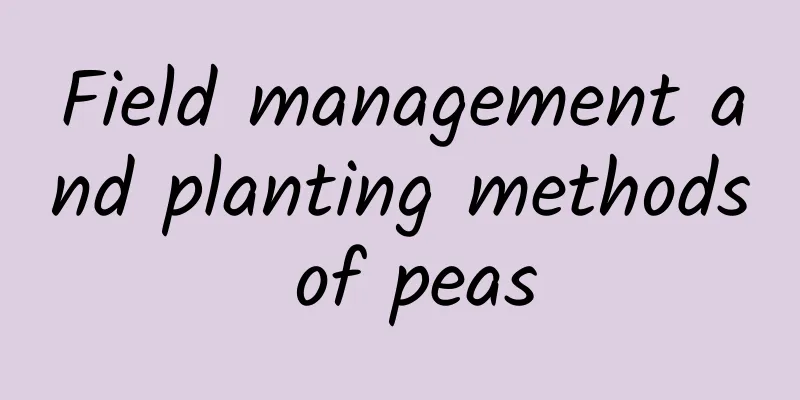Field management and planting methods of peas

|
Everyone should know peas , which are one of the common dishes. Let's learn about the field management of peas: 1. Cultivation and soil cultivationPeas are prone to weeding during the seedling stage, so they need to be weeded 2 to 3 times. Generally, the first weeding is done when the plant height is 5 to 7 cm, and the second weeding is done when the plant height is 10 to 15 cm, combined with soil cultivation. The third weeding should be done flexibly according to the growth of the peas. In the later stage, the stems and leaves are lush, and weeding can easily damage the plants. When there are many weeds, they must be removed manually. 2. Picking and trellisingWhen the creeping peas are about 30 cm tall, a trellis must be built. Otherwise, the stems and vines will crawl on the ground, which will not only make field management and harvesting inconvenient, but also make the lower stems and leaves prone to rot and disease. After the trellis is built, ventilation and light transmission are good, the stems and vines are strong, the rot at the base is reduced, the pods are more, the grains are full, and the yield can be increased by more than 1 times. Some varieties need to be pinched when the plant is 30 cm tall to promote the growth of side branches, increase the number of flowers and fruiting rate. The picked tender tips can also be used as a trellis. Eaten as vegetables. 3. FertilizationPea fertilizer should be mainly based on basal fertilizer. In addition to applying compost and manure, more phosphorus and potassium fertilizers, such as wood ash and bone meal, should be applied. If rhizobia can be used to mix seeds during sowing, the effect will be better. Pea rhizobia can fix nitrogen, so there is no need to apply more nitrogen fertilizer; but in the seedling stage and when the soil is poor and lacks basal fertilizer, a small amount of quick-acting nitrogen fertilizer can be applied to promote the growth of multiple stems and leaves. Peas need to be applied with more phosphorus and potassium fertilizers. Phosphorus fertilizer can promote the maturity of pea grains and improve their boiling softness. Peas have a higher utilization rate of insoluble phosphorus fertilizers, and there is a significant yield-increasing effect after application; superphosphate can also be applied. Spraying phosphorus fertilizers on the roots of peas during the flowering and podding period, especially spraying with trace element fertilizers such as boron, manganese, and molybdenum, has a very significant yield-increasing effect. 4. IrrigationPeas have poor drought tolerance, so during the growth period, attention should be paid to irrigation to keep the soil moist. If drought occurs after sowing, water must be irrigated quickly to facilitate seed germination and emergence. More water is required during the flowering and podding period. |
<<: The medical effects and benefits of peas
>>: Key points for cultivating pea seedlings in autumn
Recommend
How to cultivate Buddha's hand to gold? Cultivation methods and precautions of Buddha's hand to gold
Buddha's Hand Gold, also known as Buddha'...
How is ChaCha? ChaCha review and website information
What is ChaCha? ChaCha is the world's leading ...
How to wash blueberries How to wash blueberries most cleanly
Blueberry is a special fruit with high nutritiona...
Can bamboo shoots cure diseases? Common uses of bamboo shoots for curing diseases
Bamboo shoots are a common food that many people ...
Intersil_How is Intersil? Intersil_Reviews and website information
Intersil Corporation is a manufacturer of analog s...
The efficacy and function of Dendrobium officinale flowers The medicinal value of Dendrobium officinale flowers
Many people have eaten Dendrobium candidum. They ...
The efficacy and function of purple-backed evergreen
Purple-backed Dieffenbachia is a common green pla...
How is Czech Airlines? Czech Airlines reviews and website information
What is the website of Czech Airlines? Czech Airli...
What can't be eaten with boiled eggs?
Boiled eggs are a kind of food that people often ...
The efficacy and function of plum wine and the production method of plum wine
Plum is a very popular fruit in life. This fruit ...
How is RAE? RAE review and website information
What is RAE? RAE (Research Assessment Exercise) is...
Nutritional value of basil
Do you have the habit of eating snails? If you ea...
What is Korea Times like? Korea Times reviews and website information
What is Korea Times? Korea Times is famous for its...
How to distinguish true and false bamboo fragrant rice How to distinguish true and false bamboo fragrant rice
Many people have heard of bamboo-scented rice. It...
Cultivation methods and precautions of potted yew
Potted yew is an ornamental plant that many peopl...









